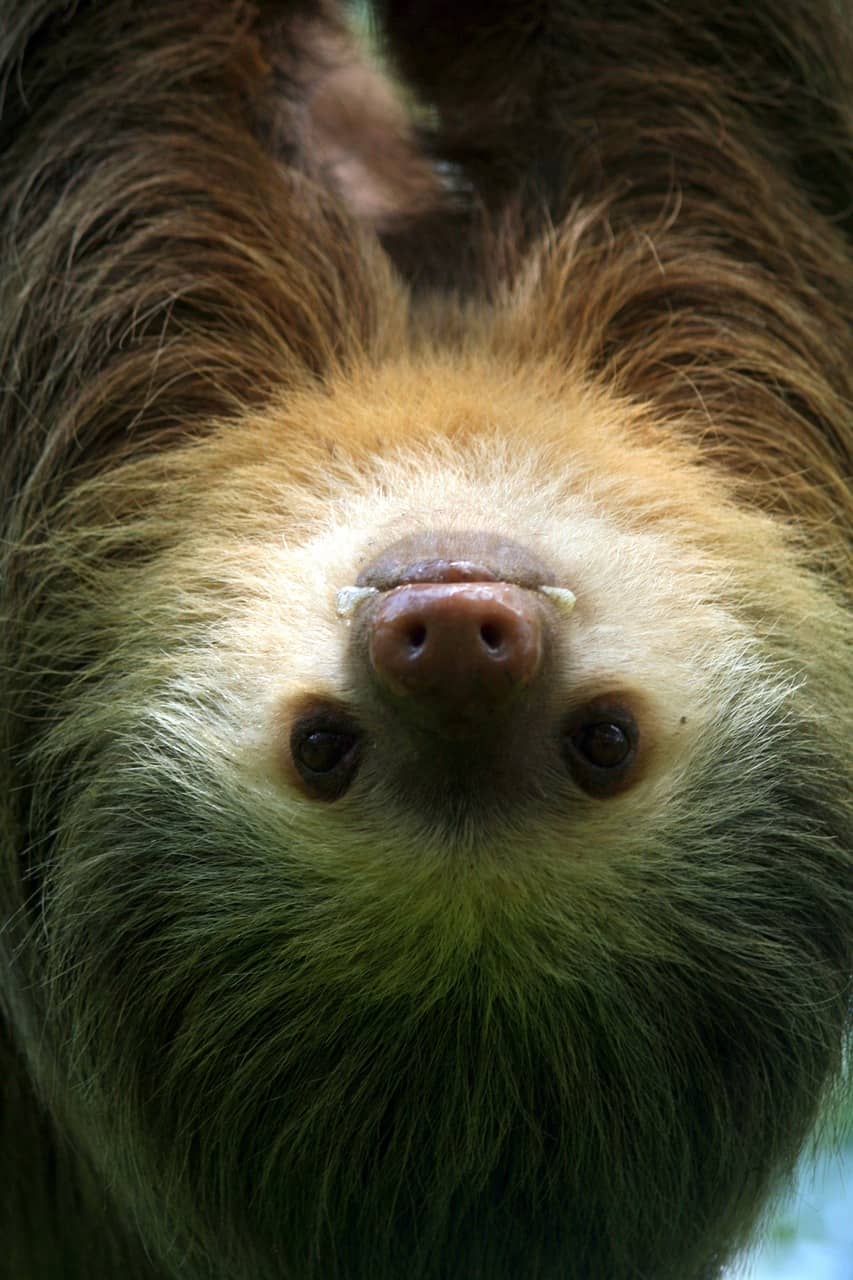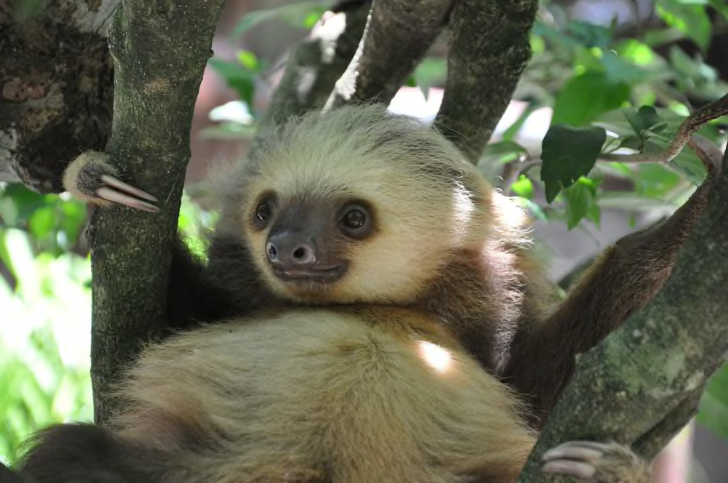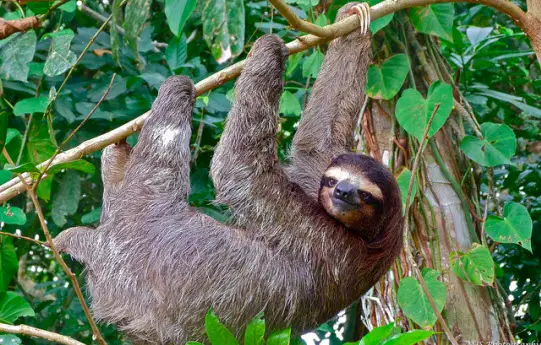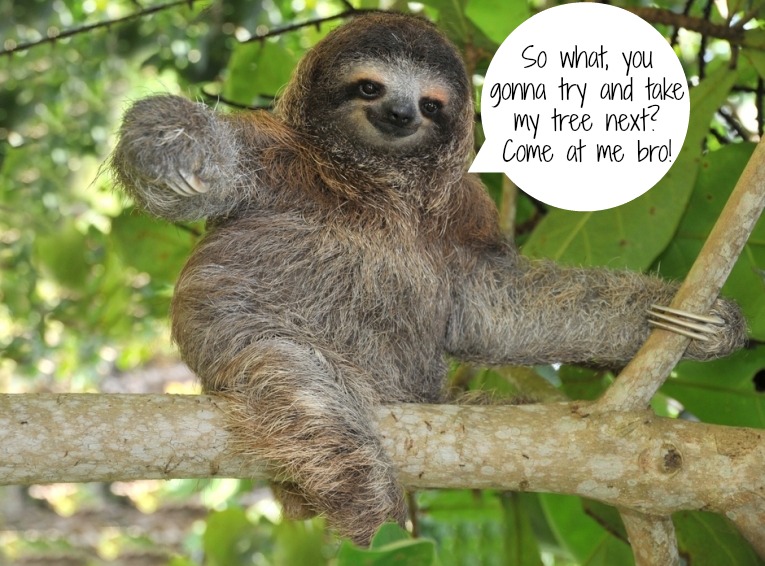A Sloths Habitat
Two-Toed Sloth Facts and Information Choloepus Introduction to Two-Toed Sloth. There are two species of the Two-Toed Sloth, and they mainly spend their lives in the trees. They blend in very well so it isn’t common for a person to be able to see one other than in captivi. Sloths are anatomically designed to fall out of trees. On average, a sloth will fall out of a tree once a week for its entire life. But don't worry, all sloths are anatomically designed to fall. The common ancestor of the two existing sloth genera dates to about 28 million years ago, with similarities between the two- and three- toed sloths an example of convergent evolution to an arboreal lifestyle, 'one of the most striking examples of convergent evolution known among mammals'. The ancient Xenarthra included a much greater variety of species, with a wider distribution, than those of.
- Describe A Sloths Habitat
- Sloth Animal Facts
- Facts About A Sloths Habitat
- Things In A Sloths Habitat
- Sloth Fun Facts For Kids
The sloth is the world's slowest mammal, so sedentary that algae grows on its furry coat.
Amazing Facts About the Three Toed Sloth
- Sloths are identified by the number of long, prominent claws that they have on each front foot. There are both two-toed and three-toed sloths.
- There are four living species of three-toed sloths; these are the brown-throated sloth, the maned sloth, the pale-throated sloth, and the pygmy three-toed sloth which was only recognised as a distinct species in 2001.
- The pygmy three-toed sloth can only be found on Isla Escudo de Veraguas which has been separated from mainland Panama for 9,000 years. The major threat to the pygmy three-toed sloth is habitat destruction which is reducing the size of its already small habitat.
- Being the world’s slowest mammal, the sloth travels at a top speed of 0.24 kilometres per hour (0.15 mph). They are so sedentary that algae grows on their furry coat.
- Sloths make a good habitat for other organisms, and a single sloth may be home to moths, beetles, cockroaches and fungi aswell as algae.
- The three-toed sloth is arboreal (tree-dwelling), with a body adapted to hang by its limbs; the large curved claws help the sloth to keep a strong grip on tree branches. It lives high in the canopy but descends once a week to defecate on the forest floor.
- Sloths sleep in trees – some 15 to 20 hours every day. Even when awake they often remain motionless.
- At night they eat leaves, shoots and fruit from the trees and get almost all of their water from juicy plants.
- Dead sloths have been known to retain their grip and remain suspended from a branch
- Sloths will move between different trees up to four times a day, although they prefer to keep to a particular type of tree, which varies between individuals, perhaps as a means of allowing multiple sloths to occupy overlapping home ranges without competing with each other.
- Although they are quite slow in trees, three-toed sloths are agile swimmers.
- On land, sloths’ weak hind legs are not very powerful and their long claws are a hindrance. They cannot walk on all four limbs so they must use their front arms and claws to drag themselves across the rain forest floor.
- If caught on land, these animals have no chance to evade predators such as big cats and must try to defend themselves by clawing and biting.
- In trees the sloth’s greenish color and its sluggish habits provide an effective camouflage; hanging quietly, the sloth resembles a bundle of leaves.
- The three-toed sloth, unlike most other mammals, does not fully maintain a constant body temperature, and this limits it to warm environments.
- Sloths mate and give birth while hanging in the trees. Females give birth to a single young after a gestation period of around six months.
- Three-toed sloth babies are often seen clinging to their mothers — they travel by hanging on to them for the first nine months of their lives.
- Once sloth babies are weaned, the mother leaves her home territory to her offspring and moves elsewhere.
- Adults are solitary, and mark their territories using anal scent glands and dung middens.
- Sloths have extra neck vertebrae that allows them to turn their heads some 270 degrees.
- Extinct sloth species include many ground sloths, some of which were as big as elephants.
Photo: www.animalstown.com
Find more animals like this
Quick Facts
- Type: Mammal
- Diet: Herbivore
- Lifespan: 25-30 years
- Size: 56-60cm
- Habitat: Tree dwelling in rain forest
- Range: South and Central America
- Scientific name: Bradypus
Sloths are tree-dwelling mammals that live in the rainforests of South and Central America. In this article, which is part of our Rainforest Animals series, we’ll look at the sloth’s life and habitat, and learn where it fits within the rainforest ecosystem. At the end is a list of sloth facts for kids.
Watch the videos further down the page to see sloths in the wild!
Sloth Facts At-A-Glance



- Type of Animal: Mammal
- Order: Pilosa
- Number of Sloth Families: 2. Two-toed sloths (Megalonychidae) & three-toed sloths (Bradypodidae).
- Number of Sloth Species: 6 (see below for descriptions & conservation status)
- Where Found: Rainforests of Central and South America
Sloth Information
Sloths are arboreal (tree-dwelling) mammals that live in the rainforests of South and Central America. They are named after the deadly sin of sloth (which means laziness) because they move extremely slowly.
Sloths move so slowly that algae (plant-like organisms) grow in their fur! This is actually beneficial to sloths, as it gives them a slightly greenish color, helping them to blend in with their surroundings!
Sloths spend most of their lives in the trees, where they hang upside-down from branches and vines. Sloths eat, sleep, mate and even give birth while hanging around in the trees!
Due to the design of their feet and long, curved claws, sloths can hang upside down with little or no effort. This actually makes them a less appealing target for human hunters because even when shot, sloths remain hanging in the trees.
Sloths are mostly nocturnal, and sleep during the day.
6 Species, 2 Families
There are six species of sloth, divided between two families: two-toed sloths (Megalonychidae) and three-toed sloths (Bradypodidae).
You can tell the difference between the two families by counting how many ‘fingers’ they have. Two-toed sloths have two fingers; three-toed sloths have three.
Perhaps they should have been named two and three fingered sloths; both families of sloths have three toes on their hind legs!
Two-toed Sloths (Megalonychidae family)
There are two species of two-toed sloth:
- Linnaeus’s two-toed sloth (Choloepus didactylus) (Conservation status: Least Concern)
- Hoffmann’s two-toed sloth (Choloepus hoffmanni) (Conservation status: Least Concern)
Two-toed sloths are slightly larger and faster-moving than three-toed sloths. They are around 60 cm – 70 cm (24 – 28″) in length, and weigh about 6 kg (13 pounds).
Three-Toed Sloths (Bradypodidae family)
There are four living species of three-toed sloth:
- Brown-throated sloth (Bradypus variegatus) (Conservation status: Least Concern)
- Maned sloth (Bradypus torquatus) (Conservation status: Vulnerable)
- Pale-throated sloth (Bradypus tridactylus) (Conservation status: Least Concern)
- Pygmy three-toed sloth (Bradypus pygmaeus) (Conservation status: Critically Endangered)
Three-toed sloths are smaller and slower than two-toed sloths. They grow to around 45 cm – 60 cm (18 – 24″) in length and weigh around 4 kg (9 pounds). Although their tails are longer than those of the two-toed sloths, they are still quite short, reaching 6–7 cm (2–3 in) in length.
Sloth Video
Watch this video to see a sloth in its natural habitat:
Sloth Facts: What Do Sloths Look Like?
Sloths have fairly small, thin bodies with short tails. Their heads are small and round, with short snouts, small ears, and large eyes surrounded by dark masks. The shape of their mouths gives them a permanent smiling expression!
Sloths have long, curved claws. These can grow to be up to 3 – 4 inches (8 – 10 cm) long. Sloths use their claws to climb trees and to hook themselves onto branches.
The long limbs and claws of a sloth are designed for hanging and climbing, not for walking on the ground. Sloths have great difficulty getting around when on the floor, as this video shows …
A Living Habitat!

The sloth’s long, shaggy hair is home to algae, small plants and bugs such as moths and beetles. This is due to a combination of the sloth’s slow speed and the warm, damp climate of the rainforest.
Sometimes the sloth will even lick algae and plants off of its fur as a snack!
Describe A Sloths Habitat
What Do Sloths Eat?
Sloths are folivores (specialist leaf-eaters), and also eat buds and shoots. Their bodies and lifestyles reflect their diet. Leaves contain very little energy and are also low in nutrients. As a result, sloths have large and complex stomachs, which contain bacteria that break down the leaves.
It can take a sloth a month to completely digest a meal! Sloths climb down from the trees in order to urinate and defecate (poop!) only about once a week. The contents of a sloth’s stomach account for as much as two-thirds of its body weight.
Because leaves contain very little energy, sloths have a low metabolism (the rate at which energy is used by an organism).
Two-toed sloths have been observed eating insects, lizards and birds in addition to plant matter.
How Fast (Slow?!?) Is A Sloth?
Sloths move extremely slowly, only managing to cover about 6 – 8 feet (1.8 – 2.4 meters) per minute.
Sloth Animal Facts
As a (not very scientific) comparison, walking at your normal speed you’d probably be moving at about 275 feet (84 meters) per minute. That’s close to the length of a standard soccer / football pitch.
So even when walking you’re about 39 times faster than a sloth!
Deep Sleepers
Sloths spend most of their time either eating or sleeping. In the wild, sloths sleep between 9 and 15 hours a day.
Can Sloths Swim?
They may not be very good on the ground, but sloths are good swimmers. They use a lazy, doggy-paddle stroke to propel themselves through the water.
Watch the amazing video below to see a sloth swimming:
Keeping Cool
Due to their low metabolism, sloths have the lowest body temperature of any mammal, and can’t shiver to keep warm.
Sloth Predators
Sloths are hunted by several rainforest animals, including jaguars, ocelots, harpy eagles, and green anacondas.
It’s much easier for a predator to spot prey that is moving. Because sloths spend so much time either motionless or moving very slowly, they often avoid detection.
Facts About A Sloths Habitat
Sloths are very vulnerable when on the ground and tend to spend as little time as possible out of the safety of the trees.
When cornered or feeling threatened, sloths will lash out with their long front claws.
Additional Sloth Facts
- Thousands of years ago, giant sloths roamed North America. These elephant-sized animals became extinct about 10,000 years ago.
- Sloths eat, sleep, and live most of their lives hanging upside down.
- If a sloth feels threatened it might put on a ‘burst of speed’ and travel at 13 ft. (4 m) per minute.
- Sloths are mainly nocturnal, but some are also known to be diurnal (active during the day).
Sloth Activities For Kids
Things In A Sloths Habitat
- Think about what you can do to help stop deforestation and save the homes of rainforest animals. Write a short story about what you can to do to help save sloths’ homes.
- Gather some friends for a sloth race! Whoever crosses the finish line last is the winner!
- Draw a picture of a sloth hanging out in the rainforest canopy. Don’t forget to include the leaves, flower buds and twigs that sloths like to eat!
- Check out the Sloth Sanctuary in Costa Rica.
Sloth Facts For Kids Conclusion
We hope that you have enjoyed learning about sloths. They are just one of the many animals who call the rainforest their home. Now you’re a sloth expert, why not find out about more rainforest animals? Visit our Main Rainforest Animals Page to get started!
Sloth Fun Facts For Kids
Love Animals? Join Our Free Newsletter List!

Join the FREE Active Wild Newsletter List. A must for all animal fans. Awesome animal facts and information delivered direct to your inbox. It’s absolutely free, you can unsubscribe at any time, and we’ll never share information with anyone else. Click here for info: Subscribe to Active Wild.